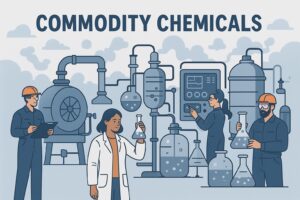1. Gujarat Narmada Valley Fertilizers & Chemicals (GNFC)
Overview: GNFC, established in 1976, operates in the fertilizers and chemicals sectors, with a diversified portfolio including fertilizers, industrial chemicals, and information technology services.
Business Model and Segments:
- Fertilizers: Urea, ammonium nitrophosphate, and other nitrogenous fertilizers.
- Chemicals: Methanol, formic acid, nitric acid, and acetic acid.
- Information Technology: GNFC IT Services.
Future Strategies:
- Expand specialty chemicals portfolio.
- Increase export activities.
- Leverage IT for operational efficiency.
Strengths:
- Diverse product range.
- Robust distribution network in India.
- Strategic investments in technology and sustainability.
Weaknesses:
- Dependence on government subsidies.
- Exposure to volatile raw material prices.
Profit Formula:
- Revenue primarily from fertilizer sales, supported by subsidies.
- High-margin industrial chemicals contributing significantly to profits.
2. Chambal Fertilisers and Chemicals Limited (CFCL)
Overview: CFCL, part of the K.K. Birla Group, is one of India’s largest private-sector fertilizer producers, established in 1985.
Business Model and Segments:
- Fertilizers: Urea as the flagship product, along with other nitrogenous fertilizers.
- Agribusiness: Seeds, pesticides, and other agricultural inputs.
- Specialty Chemicals: Niche chemicals for industrial use.
Future Strategies:
- Enhance production capacity for urea and other fertilizers.
- Expand agribusiness product range.
- Invest in sustainable and eco-friendly practices.
Strengths:
- Leading position in the urea market.
- Strong brand recognition and customer loyalty.
- Efficient production facilities.
Weaknesses:
- High dependency on a single product (urea).
- Regulatory risks related to subsidies and environmental policies.
Profit Formula:
- Major revenue from urea sales.
- Agribusiness and specialty chemicals providing additional revenue streams.
3. Rashtriya Chemicals and Fertilizers Limited (RCF)
Overview: RCF, a Government of India undertaking, is a prominent player in the fertilizer and chemical industry, established in 1978.
Business Model and Segments:
- Fertilizers: Urea, complex fertilizers, and bio-fertilizers.
- Chemicals: Methanol, ammonia, nitric acid, and ammonium nitrate.
- Industrial Products: Solvents and other industrial chemicals.
Future Strategies:
- Increase production capacity for both fertilizers and chemicals.
- Develop and promote eco-friendly bio-fertilizers.
- Explore new markets for exports.
Strengths:
- Government backing and support.
- Extensive production facilities.
- Strong distribution network.
Weaknesses:
- Bureaucratic and administrative challenges.
- High reliance on government policies and subsidies.
Profit Formula:
- Revenue from fertilizer sales, with significant government subsidies.
- Industrial chemicals providing additional profit margins.
4. Deepak Fertilisers and Petrochemicals Corporation Limited (DFPCL)
Overview: DFPCL, established in 1979, is a leading manufacturer of industrial chemicals and fertilizers, with a strong focus on value-added products.
Business Model and Segments:
- Fertilizers: Nitro-phosphate, Bentonite Sulphur, and other complex fertilizers.
- Chemicals: Iso-propyl alcohol, nitric acid, methanol, and other industrial chemicals.
- Mining Chemicals: Specialty chemicals for mining and infrastructure.
Future Strategies:
- Diversify into high-margin specialty chemicals.
- Expand capacity in mining chemicals and fertilizers.
- Focus on sustainability and green initiatives.
Strengths:
- Diverse product portfolio with high-margin products.
- Strong R&D capabilities.
- Significant presence in the industrial chemicals market.
Weaknesses:
- Exposure to volatile chemical market prices.
- Regulatory and environmental compliance costs.
Profit Formula:
- Revenue from fertilizers and high-margin industrial chemicals.
- Specialty chemicals contributing to overall profitability.
Financial Indicators and Recent Developments
Market Capitalization (as of latest data):
- GNFC: ₹7,800 crores
- CFCL: ₹13,000 crores
- RCF: ₹5,600 crores
- DFPCL: ₹8,900 crores
Recent Developments:
- GNFC: Investment in IT infrastructure and new chemical plants.
- CFCL: Expansion of urea production capacity.
- RCF: Launch of new eco-friendly bio-fertilizers.
- DFPCL: Strategic partnerships for technology upgrades and capacity expansion.
Conclusion
GNFC, CFCL, RCF, and DFPCL are key players in the fertilizer and chemical industry, each with its unique strengths and strategies. GNFC leverages its diversified portfolio and IT capabilities, CFCL focuses on its leading position in urea production, RCF benefits from government backing, and DFPCL stands out with its high-margin specialty chemicals. Understanding their business models, market segments, and strategic directions provides valuable insights into their competitive dynamics and future prospects in the industry.




